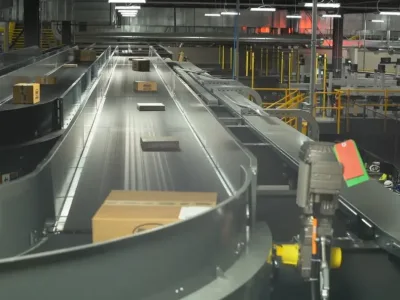
The robotic future of manufacturing
China for example has seen astonishing growth since surpassing the US as the number one global manufacturer in the world in 2010. With this, the country has been able to deliver high productivity and low costs that have attracted huge investments from foreign companies. China’s manufacturing industry continues to transform as demand for more specialised goods brings production costs up, opening the door to the next major innovation for manufacturing – factory automation.
‘Lights Out’ on old manufacturing strategies
‘Lights out manufacturing’ refers to the use of robotics in fully automated factories where materials and products are produced 24/7 with little human workforce present. In 2016, a Chinese mobile phone factory, Changying Precision Technology Company, deployed a factory workforce that was 90% robotic. While not quite ‘lights out’, Changying still saw productivity increase by 250%.
One of the most well-known lights out manufacturing facilities actually produces the robots that enable other companies to deploy lights out manufacturing. FANUC’s robots produce other robots in Japan for automated factories all over the world, including Apple and Tesla Motors in the US.
Many believe that lights out manufacturing represents a game-changing innovation for the manufacturing sector, setting a new bar for productivity. However, there are other benefits to automated factories, including throughput and quality increases, more consistent labour costs and lower energy requirements.
Robots are also objective, relying on programming to dictate what is ‘right’ and ‘wrong’. This is very important on the manufacturing line, especially if the robots are responsible for providing a non-biased inspection.
Robotic-based solutions are now being implemented in the functional testing of mobile devices. These solutions offer an automated processing capability for carriers and mobile device operators, to reduce the costs surrounding the testing of mobile phones that enter the reverse logistics supply chain.
With robots, device inspection is streamlined, helping to avoid a scenario where a refurbished phone isn’t rated correctly. Automating the process also increases objectivity and improves consistency for grading devices, which is particularly beneficial in the second-hand and refurbished devices market. If a robot grades a device as the highest possible rating, consumers can be assured they’re buying a product that fits the package description.
Of course one consistent argument that arises when talking about automation is its impact on the jobs market. However, what automation can, and indeed does, actually do is to remove the repetitive nature of certain jobs on the assembly line traditionally done by human workers and free their time up for less menial tasks. In addition, small hardware automation systems can aid in terms of keeping production in existing ‘home’ factories rather than moving operations offshore because of labour costs.
Lights out manufacturing can be expensive to implement and it doesn’t happen overnight. Automation comes in three phases: ‘Do it better’, ‘Do it more’, and ‘Do it for less’. The Do it better phase limits human touch, reducing the risk of error and shifting resources to more strategic initiatives.
Large-scale manufacturing and forward logistics sectors have enjoyed the fruits of hardware automation for some 30 years. However, the cost, variables and complexities within the reverse logistics market (product returns/trade-ins/upgrades) have prevented truly successful automation within these environments until much more recently.
Small automation solutions now enable any Third-Party Logistics (3PL) providers to invest in smaller increments and begin to see returns in a much shorter time than traditional large-scale hardware automation offerings. Modularity and scalability are what will drive automation into the future.
Bringing value to Device Trade-in
Within low-margin markets, such as mobile device trade-in, labour costs are a significant consideration. Automation can help reduce these costs even in areas of high commoditisation and also provide the capability to deal with a broad range of devices without having to manually intervene to change the robot setup.
Industries that support product trade-in or upgrades, such as used smartphones or even used cars, are also built on the capitalisation of realising residual value. The used smartphone market intentionally discounts residual value against devices because of the variances between similarly graded devices caused by operator subjectivity.
Standard practices automatically apply a 15% discount because of these expected variances. Through automating the testing and visual inspection stages to ensure consistent, objective results, carriers and wholesalers could increase auction prices and get back that 15%. Given the billion-dollar size of the used smartphone market, that is significant value.
A Bright Future
Lights out manufacturing presents an exciting future for the manufacturing sector. We have moved a long way from jobs on the assembly lines introduced by Henry Ford, and into other more technical and service based roles within the industry. Automation can raise quality and lower processing and production costs, which in turn will open up new opportunities for UK manufacturers. As the industry moves more towards ‘lights out manufacturing, the future of UK automation has never looked brighter.
About the author:
Charles Stewardson is President of EMEA at FutureDial – www.futuredial.com
 If you enjoyed this article, you will like the following ones: don't miss them by subscribing to :
eeNews on Google News
If you enjoyed this article, you will like the following ones: don't miss them by subscribing to :
eeNews on Google News



